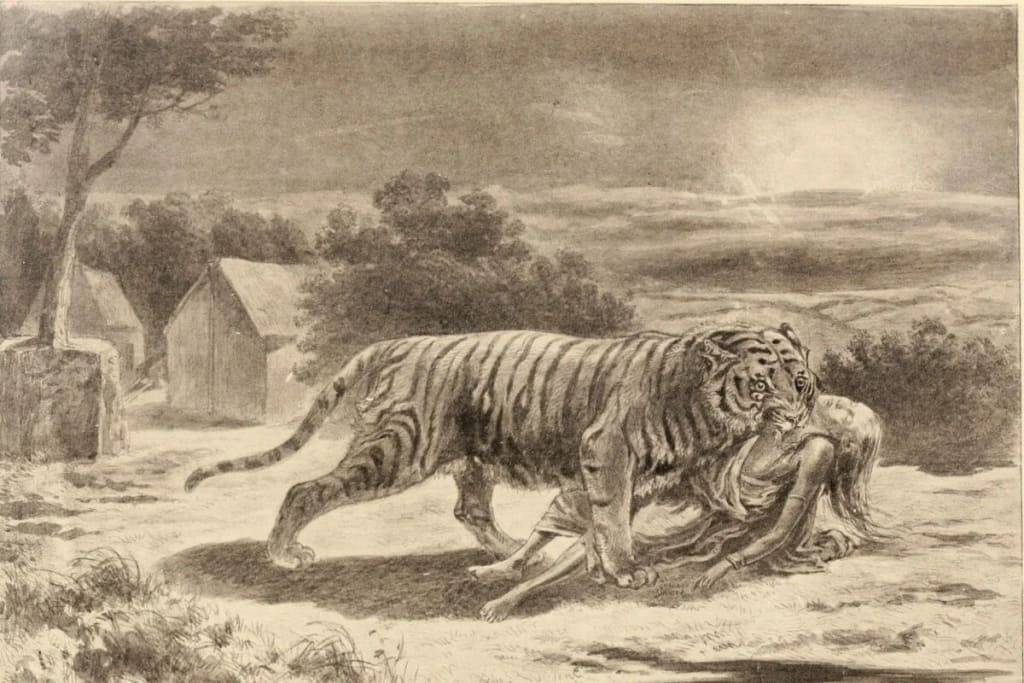Humans like to think we sit comfortably at the top of the food chain. But the truth is, for most of our existence we've been actively hunted by all manner of beasts looking to make a meal of us. These man-eating animals rack up staggering human kill counts that would make even the most infamous serial killers green with envy.
One of the deadliest man-eaters known to history was the Tigress of Champawat, who terrorized Nepal and Northern India in the early 1900s. After being injured by a gunshot, the tigress was left unable to hunt her normal prey. So she turned her sights on the soft, weak humans who lived in the forests and villages of the region. Over the course of several years, she killed an astonishing 436 men, women and children. Entire villages were abandoned as a result of her attacks. It took the legendary hunter Jim Corbett to finally track her down and end her reign of terror in 1907.
Another notorious killer was the Beast of Gévaudan, a large wolf-like creature that killed 113 people in rural 18th century France. Witnesses claimed the beast was much larger than an average wolf, leading to speculation that it may have been a hyena, lion or even a werewolf in disguise. Most victims were partially eaten. Despite intense efforts to hunt it down, the beast eluded its pursuers for years. It wasn't until 1767 that a hunter named Jean Chastel finally shot and killed the creature.
In 1898, the construction of a railway bridge in Tsavo, Kenya was plagued by not one, but two particularly savage male lions who developed a taste for workers. It's estimated that in just nine months, they killed an astonishing 135 construction workers who were dragged from their tents and consumed. The lions were so troublesome, they even halted construction at one point. Eventually famous hunter Lt. Col. John Henry Patterson shot and killed both beasts in December 1898.
The sloth bear is known as one of the most aggressive bear species. In 1957, a rogue sloth bear went on a savage rampage in the Indian state of Mysore, severely mauling over 30 people and killing 12. Partial remains of at least 3 victims were found in the bear's stomach.
In East Africa, the massive Nile crocodile nicknamed Gustave is estimated to measure over 18 feet long and weigh more than a ton. Living in the Rusizi River and Lake Tanganyika, he has killed as many as 300 people since the 1970s as revenge for bullet wounds inflicted by hunters. His reputation is so fearsome that many avoid the river rather than risk an encounter with him.
And special mention must go the lions of Tsavo - no other species can compete with humanity’s kill count. With our guns and traps, we’ve slaughtered lions to near extinction. Their global population is less than 4% of what it was 100 years ago. Our kill count over the centuries likely runs into the hundreds of thousands, if not millions. The lesson is that however deadly these man eating beasts may be, they simply can't compete with man’s ability to mindlessly destroy animal life.
In the end, stories of man-eating animals both horrify us and capture our imaginations. We turn killers like the Champawat Man-eater and Gustave into near mythical bogeymen. But the reality is complex. These animals often target humans for reasons beyond simply a thirst for blood. Injury, loss of prey, habitat loss and conflict with mankind all can all lead predators to hunt us. Their exploits inspire as much pity as fear. But there's no doubt - once a big predator develops a taste for human flesh, nothing quite strikes fear into mankind's hearts like the shadow of a man-eater creeping towards your village in the dark of night.


